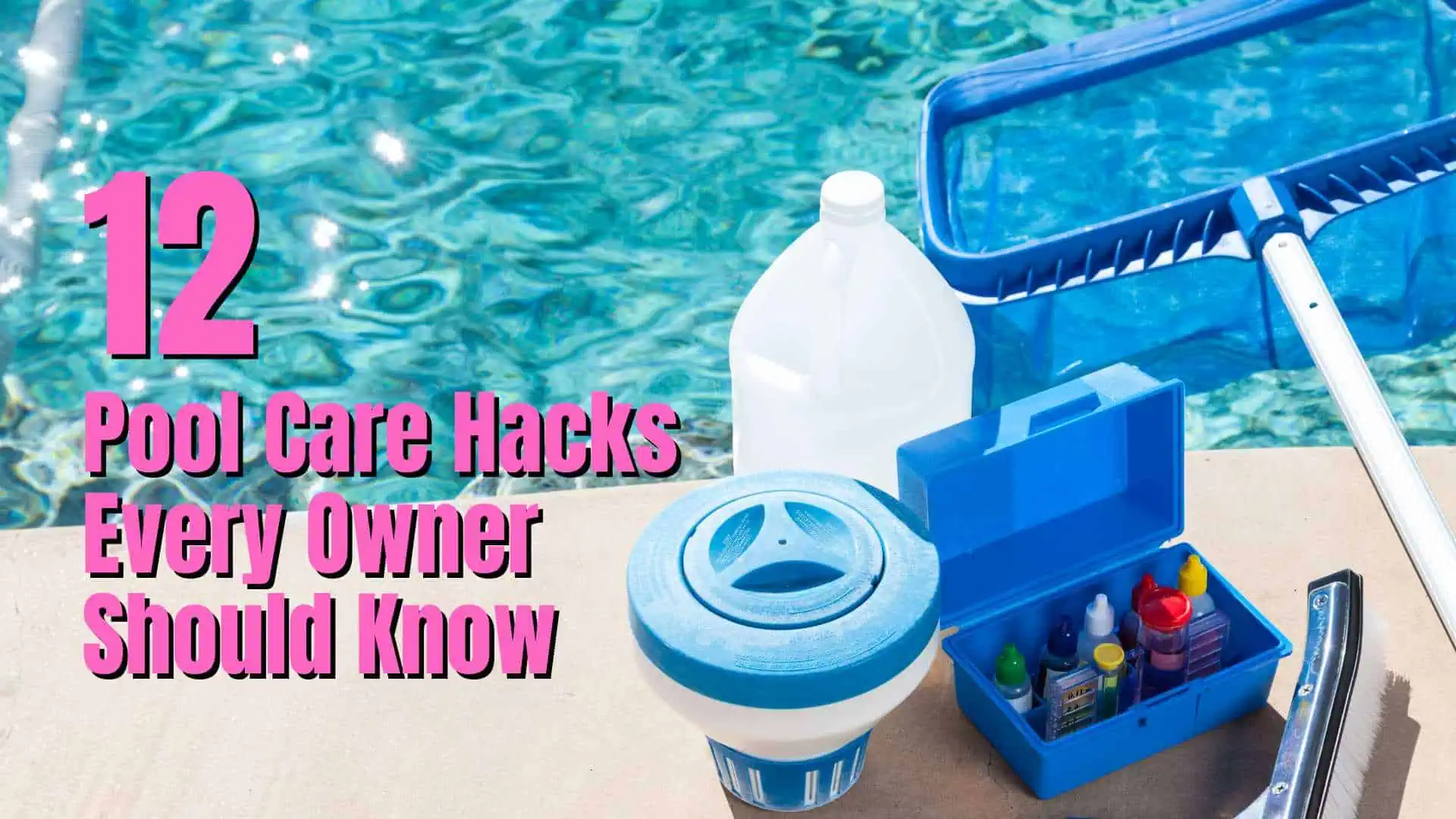Taking care of your swimming pool can seem like a daunting task, but it doesn’t have to be! With a few essential pool care tips, you can keep algae at bay and maintain a crystal clear, healthy swimming environment.
Algae growth not only ruins the appearance of your pool but also creates slippery surfaces, clogs filters and makes swimming unsafe. So, you’ll definitely want to keep algae under control.
This article will share nine essential pool care tips to help you keep algae at bay and enjoy your swimming pool to the fullest.
From regular maintenance tasks to the use of algaecides, these tips will show you how to prevent algae in pool.
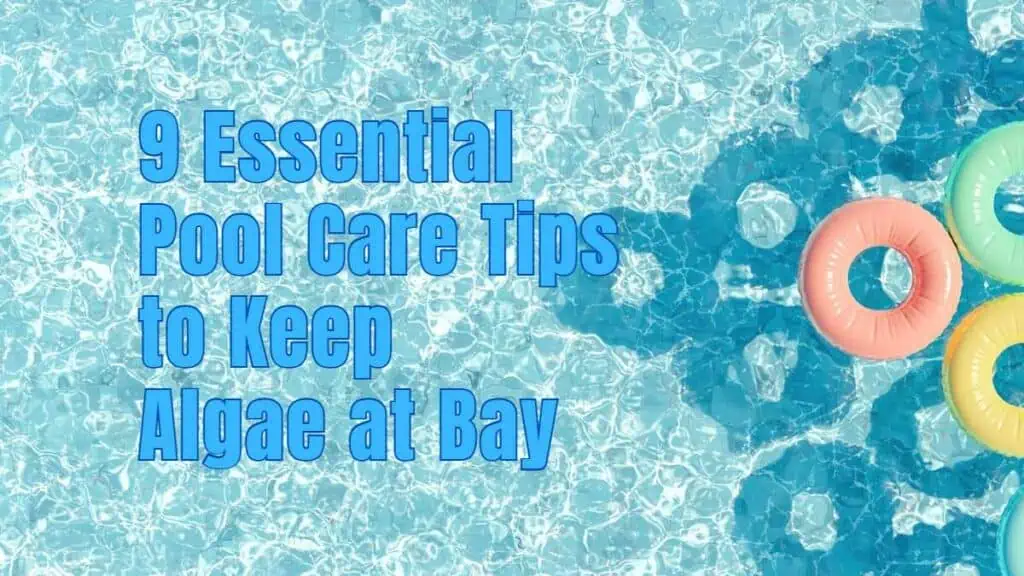
Tip #1: Maintaining Proper Pool Chemistry
Maintaining proper pool chemistry is key to preventing algae growth in your swimming pool. By ensuring that key factors, such as sanitizer levels, pH balance, and alkalinity, are in the right range, you’ll create a hostile environment for algae. Follow these essential tips to maintain proper pool chemistry.
Chlorine
First, check your pool’s chlorine level. Chlorine is a crucial sanitizer that eliminates algae and bacteria from your pool water. Regularly test the chlorine level using a test kit and aim for a range between 1 to 3 parts per million (ppm). Adjust the chlorine level in your pool as necessary to maintain this range.
pH level
Next, pay attention to your pool’s pH level. The pH of your pool water affects how effectively chlorine works as a sanitizer. Ideal pH levels should be between 7.4 and 7.6, which is slightly alkaline.
If the pH level is too low, your pool water becomes more acidic, potentially damaging your pool’s finish and equipment. Conversely, high pH levels make chlorine less effective, creating an inviting environment for algae. Adjust your pH level accordingly using pH increasers or decreasers.
Alkalinity
In addition to pH, proper alkalinity is essential for your pool’s overall water chemistry. Alkalinity serves as a buffer that stabilizes pH levels and helps prevent rapid fluctuations.
Your pool’s total alkalinity should be maintained between 80 and 120 ppm. You can adjust this using alkalinity increasers or decreasers.
Temperature
Temperature also plays a role in algae growth, as warmer water allows algae to thrive. Keep an eye on your pool’s water temperature, ensuring it doesn’t get too hot, especially during warm months. You may want to use a pool cover or a pool cooler to help regulate the temperature.
Cyanuric Acid
Lastly, remember to monitor your pool’s cyanuric acid level, which is a stabilizer that protects chlorine from sunlight degradation. Optimal cyanuric acid levels range from 30 to 50 ppm for traditional chlorinated pools and between 70 to 80 ppm for saltwater pools.
Tip #2: The Crucial Role of Pool Circulation
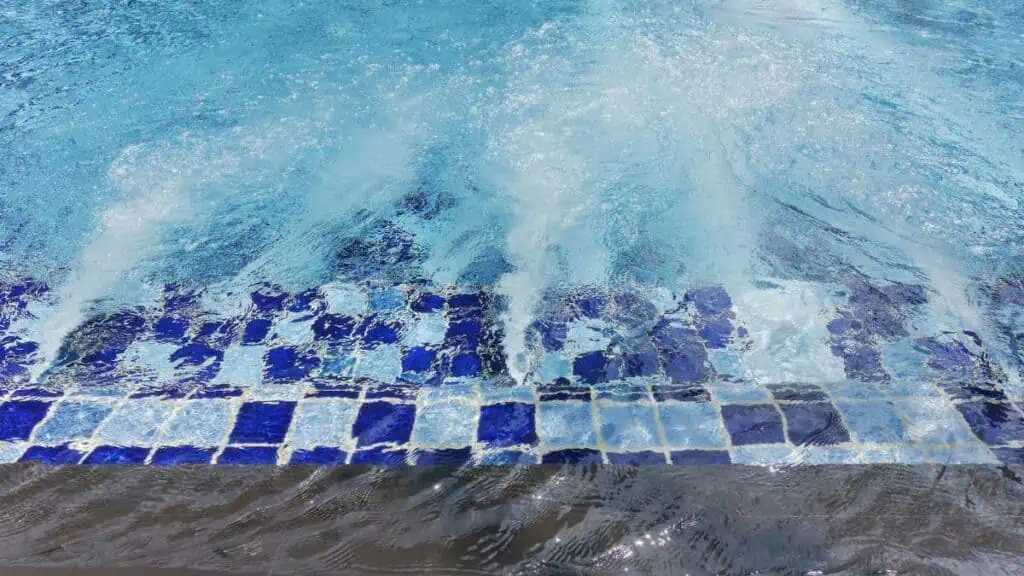
A well-maintained pool circulation system is key to preventing algae growth. Good water circulation ensures that pool chemicals are evenly distributed, helping your filtration system work more efficiently.
Your pool pump plays a vital role in maintaining pool circulation. It sucks water from the pool through the skimmer and pushes it through the filter before returning it back into the pool. A properly functioning pump ensures your pool water stays clean and healthy.
To achieve optimal water circulation, consider the following tips:
- Run your pump daily. Ensure that your pump operates for the right amount of time each day. Running it for 8-12 hours per day is generally recommended, but you might need to adjust that depending on your pool size and usage.
- Clean your pool filter regularly: Your pool filter is a critical component of your pool’s circulation system. Regularly cleaning and backwashing your filter will help it perform at its best. Check your filter’s pressure gauge and follow the manufacturer’s recommendations for proper maintenance.
- Adjust the pool jets: Point your pool jets in a specific direction to encourage better water circulation.
- Remove debris: Regularly clean your pool to prevent debris buildup, which can hinder proper water circulation.
By ensuring proper pool circulation, you’ll be one step closer to keeping algae at bay and enjoying a sparkling clean pool all season long.
Tip #3: Regular Brushing and Scrubbing: Your First Defense Against Algae
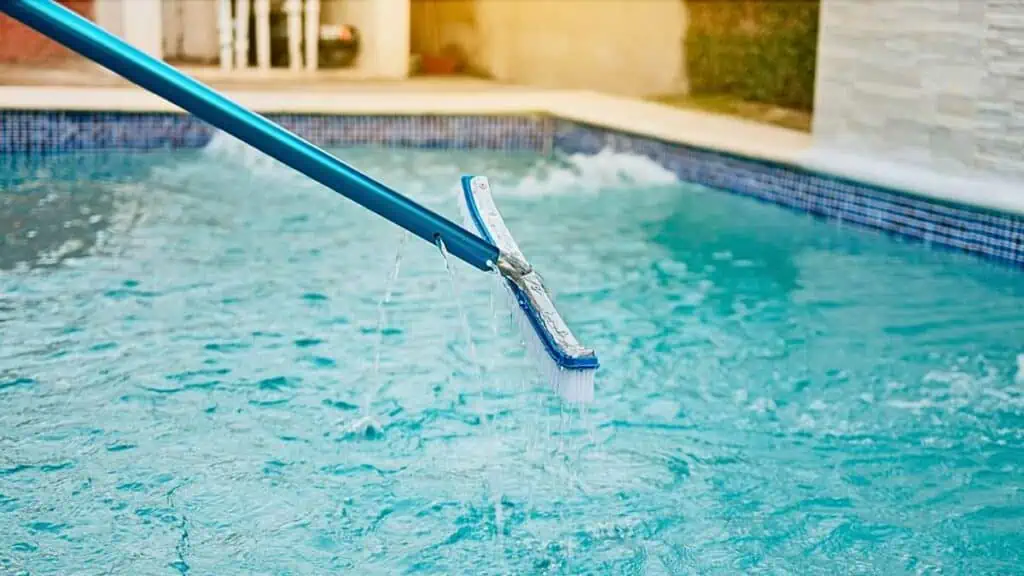
Regular brushing and scrubbing are your first defense against algae growth. Keeping your pool clean makes it harder for algae to thrive in the first place. So, let’s dive into the importance of regular brushing and how it greatly benefits your pool’s cleanliness.
Algae love to cling onto pool walls and other surfaces, which is why brushing the pool walls is essential. Once algae is removed from the pool walls etc the chlorine in the water can attack it easier.
Aim to brush your pool walls at least once a week, or more, depending on factors like heavy use or weather conditions since they can increase the likelihood of algae growth.
When brushing your pool, it’s important to use the right kind of brush for your pool surface. For example, if your pool has a smooth, vinyl surface, it’s best to use a nylon brush, as it’s gentle enough not to damage the liner. However, a wire brush might be more appropriate for removing algae stubbornly clinging to the surface if your pool has a plaster or concrete surface.
By brushing regularly, you’ll also help your pool’s circulation system effectively distribute sanitizing chemicals and ensure a more evenly balanced pool. This will promote a cleaner, healthier pool environment that is less inviting to algae growth.
Tip #4: Remove Leaves
Leaves and other organic debris left in the pool to decompose will help algae to bloom.
Make sure that you regularly use a pool net to remove leaves and other floating organic debris before they have a chance to become waterlogged and sink to the bottom of the pool.
If they do sink to the bottom then use a leaf rake/net to remove them before they decompose. A pool net that includes a think scoop that slides along the bottom of the pool, picking up leaves, such as the AnSun Pool Skimmer Net below is ideal.
Read: How to remove leaves from a pool
Tip #5: Efficient Use of Algaecides
Algaecides can be a helpful addition to your pool care routine, helping you keep algae at bay and maintaining a clean and inviting pool environment. Although chlorine is the most effective solution for killing algae, using algaecides as a secondary sanitizer can be beneficial.
First, it is important to ensure you are using the right type of algaecide for your pool. Some algaecides contain copper, which can cause staining and oxidation in pools with high metal content. If you suspect your pool has high metal levels, opt for a copper-free algaecide to protect your pool surfaces.
When it comes to applying algaecides, consistency is key. Incorporate the use of algaecides into your weekly pool maintenance routine. This ensures that the algaecide remains at a sufficient level throughout the week, enhancing its effectiveness in keeping algae growth under control.
Remember, algaecides work best as a preventative measure rather than a cure-all solution for an existing algae problem. It’s essential not only to apply the algaecide but also to ensure your pool has balanced water chemistry. Regularly test your pool’s pH, chlorine, and other chemical levels to maintain optimal conditions that discourage algae growth.
Finally, here are a few friendly reminders when using algaecides in your pool:
- Always follow the manufacturer’s instructions regarding dosage and application.
- Be cautious about using algaecides with other pool sanitizers, as some products may not be compatible.
- Keep a close eye on your pool’s appearance and water clarity, as these can be early indicators of algae growth.
With these tips in mind, you’ll be well on your way to efficiently using algaecides and keeping your pool algae-free.
Read: Don’t use too much algaecide
Tip #6: Importance of Pool Shocking
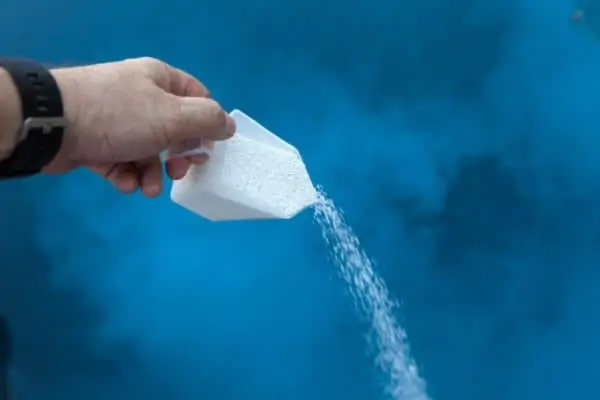
Pool shocking is crucial in maintaining your swimming pool and ensuring it stays algae-free.
Shocking your pool refers to adding a high dose of chlorine or a chlorine shock treatment to your swimming pool water. This process raises the chlorine levels to destroy organic matter such as algae, bacteria, and other contaminants that can cause unpleasant odors and discoloration. By eradicating these contaminants, you can ensure a crystal clear and safe swimming environment for you and your family.
You should shock your pool regularly to maintain water hygiene. It is generally recommended to shock your pool every one to two weeks. However, if you have pool parties, outdoor gatherings, or experience severe weather, you should shock your pool more often.
Watch out for signs like cloudiness, discoloration, or strong odors, as they indicate it’s time for a pool shock.
To shock your pool effectively, follow these steps:
- Test the water to ensure the pH levels are between 7.2 and 7.6.
- Determine the amount of shock treatment needed based on your pool size and the severity of algae growth (usually 2-4 lbs of shock per 10,000 gallons of water).
- Dissolve the shock treatment in a bucket of water, stirring it well.
- Pour the mixture evenly around the perimeter of the pool in the evening or night when the sun isn’t shining.
- Run your pool filter for at least 8 hours after shocking, and avoid swimming until the chlorine levels have returned to a safe range (2.0-4.0 ppm).
Ideally, you should shock your pool in the evening and leave the pool pump running overnight as the effectiveness of the chlorine will not be reduced by the sun.
Read: How long to wait before swimming after shocking a pool
Tip #7: Keeping Phosphate Levels in Check
Keeping the phosphate levels in your swimming pool under control is essential to prevent pesky algae from growing and multiplying. Phosphates are a food source for algae, so maintaining the right balance can help keep your pool sparking clean and algae-free.
To keep phosphate levels in check, testing the water regularly is crucial. Ideally, phosphate levels should not exceed 100 ppb (parts per billion). When levels reach 300 ppb or higher, the risk of algae development significantly increases. Testing your pool’s phosphate levels is simple with a phosphate test kit, available at most pool supply stores.
In case your pool’s phosphate levels are high, there are effective ways to lower them. First, ensure that your pool’s filtration system is functioning properly. A well-maintained filter can help remove phosphates from the water, keeping algae at bay. Make sure to clean your filter regularly and replace it as needed.
Next, consider using a phosphate remover, a chemical treatment specifically targeting and removing phosphates from the water. These treatments are simple to use and can be highly effective in maintaining a healthy, algae-free pool. Just remember to follow the product’s instructions carefully as overdosing can lead to water quality issues.
Tip #8: The Value of Pool Filters in Algae Prevention
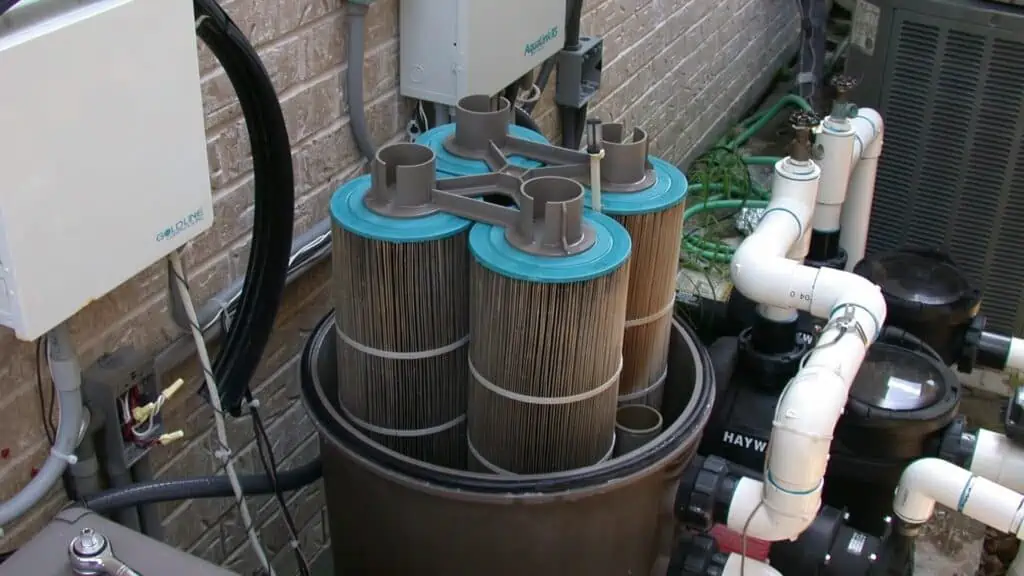
A clean pool filter is essential for keeping algae at bay and maintaining crystal-clear waters. Your filtration system serves as the heart of your pool, ensuring that debris, dirt, and unwanted growths receive prompt removal from the water. Regular use of your pool filter helps prevent the formation of algae blooms and contributes to a healthy swimming environment.
It’s important to keep an eye on the filter’s condition to make the most of your pool filter. A clogged or dirty filter will less effectively remove algae and particulates from the water.
Make sure to clean your filter according to the manufacturer’s recommendations and replace it when necessary. For most filtration systems, this means backwashing the filter when the pressure gauge reaches a certain level.
There are various types of pool filters, with the three most common being sand, cartridge, and diatomaceous earth (DE) filters. Each filtration system has its benefits and limitations, so choosing the right one for your pool size and needs is essential.
Here’s a quick overview of the different types of filters:
- Sand Filters: These filters use a bed of sand to trap dirt and debris. They are relatively low-maintenance and cost-effective but might not be as effective at catching algae spores compared to other filters.
- Cartridge Filters: Cartridge filters utilize pleated polyester filtration material in a cylindrical shape. They offer improved performance compared to sand filters, capturing smaller particles, including algae spores. Regular cleaning and replacement of cartridges will help maintain their efficiency.
- Diatomaceous Earth Filters: DE filters offer superior filtration capabilities, making them particularly effective at removing even the finest algae spores. However, they require higher maintenance and are often more expensive than other filter options.
A well-maintained pool filter is crucial for algae prevention. By keeping your filter clean and functioning optimally, you’ll ensure a crystal-clear, algae-free pool that you can enjoy all season long.
Tip #9: The Role of Pool Covers in Algae Control
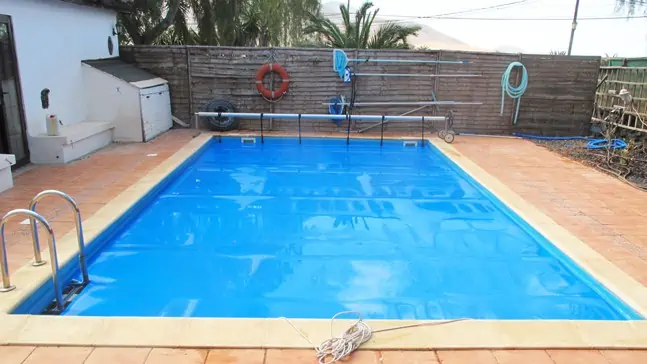
Pool covers can play a significant role in controlling algae growth in your swimming pool. By using a pool cover you will limit the amount of sunlight that penetrates the water. Since algae require sunlight to grow and multiply, blocking sunlight significantly reduces algae formation chances.
When you’re not using your pool, keeping it covered will help maintain the cleanliness of the water. This means less time spent on maintenance and more time enjoying crisp and refreshing swimming sessions.
In addition, using a pool cover can help maintain ideal water temperature and reduce evaporation, which in turn contributes to maintaining balanced chemical levels in your pool.
Various types of pool covers are available to suit your needs and budget. Some options include solid covers, solar covers, and safety covers. Each type comes with its own set of benefits and drawbacks, so consider your priorities, like safety, heating efficiency, or ease of use, when selecting the right cover for your pool.
Following these friendly tips can prevent future algae blooms and allow you to enjoy a clean and beautiful pool experience. Remember, consistency and vigilance are the keys to keeping algae at bay. Happy swimming!
Pool Care Handbook and Video Course
When I bought my house with a swimming pool, I knew absolutely nothing about pool care. I just winged it for a while, making many mistakes along the way.
Fortunately, I was recommended Swim University’s Pool Care Handbook and Video Course. I bought it and it was an absolute game-changer.
It was the best money I spent that year. I learned everything from basic cleaning to advanced troubleshooting. Swim University offers a no-quibble refund policy too so what do you have to lose?

I have had hot tubs for over 20 years and a pool for the last 10 years. I had to learn how to clean, maintain and fix them the hard way. Since then I have helped many friends and neighbors with their pools and now I want to share everything I have learned with you. About Me



